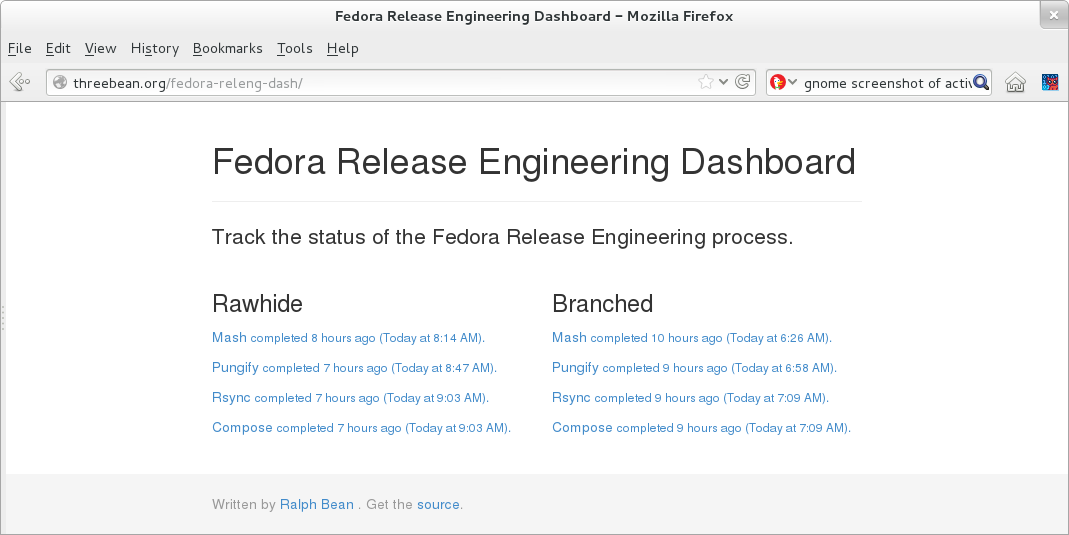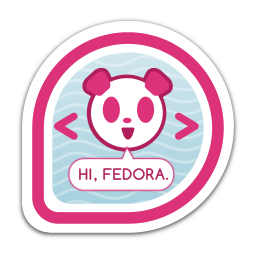[three]Bean
Fedora Badges in your Wiki Page
Sep 03, 2013 | categories: wiki, fedora, badges View CommentsIn case you missed it, Ricky Elrod wrote and deployed a mediawiki plugin for embedding Fedora Badges on your wiki page. Here's mine.
As Ricky wrote above, you can add:
{{ #fedorabadges: your_fas_username }}
where you want your badges to appear, and:
{{ #fedorabadgescount: your_fas_username }}
anywhere you want a count of your badges to appear.
A Release Engineering Dashboard?
Aug 30, 2013 | categories: releng, fedmsg, fedora, datagrepper View CommentsMessing around, I came up with a read-only dashboard for Fedora Release Engineering. You can check it out live on threebean.org.

Right now all it does is try to show the status of the compose process which runs once a day for rawhide and the "branched" pre-release (that's F20 right now). If any one of the components of that process (say, the pungify part) is happening right now, it'll tell you that and have it show up in yellow in stead of blue. If the compose hasn't happened in over 20 hours, that text will show up in gray to indicate that it is "stale" or "out of date" (those words might be too strong, but whatever).
The point of this post is to ask for feedback -- should this thing do anything more? If so, then what? Should we make it live under fedoraproject.org?
(details: It's just HTML, CSS, and js and it makes its queries against datagrepper)
New fedora-ask freenode channel (with a bot)
Aug 29, 2013 | categories: askbot, askfedora, fedmsg, fedora View CommentsIf you're in to Ask Fedora, you may want to hop on to freenode and join the new #fedora-ask channel. There's a bot there echoing just the Ask Fedora activity from fedmsg. You could use it, say, to respond more quickly to questions or to stay abrest of new trending problems.
Fedora Badges Launch
Aug 28, 2013 | categories: fedmsg, fedora, badges View Comments
We launched the new Fedora Badges webapp two weeks ago at Flock, the Fedora Contributor's Conference. It went over really well; the success was kind of stunning.
If you haven't yet, check out the site. The gist is that that frontend web interface is fed by a backend "badge awarder" which sits watching the fedmsg bus. As community members go about contributing to Fedora and interacting with infrastructure systems, they trigger the publication of new fedmsg messages. Upon receiving those messages, the badge awarder then makes a number of comparisons to determine if the person in question should receive this or that badge.

Since the launch, we've noticed an uptick on the fedmsg bus; there has been a definite increase in community activity in certain corners. Just check out the Fedora Tagger votes.
To generate the above chart, I wrote a little tool which you can find here. It uses the datagrepper API, about which I've written before.
Writing that gave us the crazy idea to add datagrepper stats to a zodbot command. Check out this IRC log from #fedora-apps:
threebean | .quote BOD monthly zodbot | BOD, bodhi -13.31% over the month preceding this one zodbot | ▄▅▆▂▁▂▄▃▄▃▁▂▄▃▃█▅▆▁▄▃▃▂▂▆▄▃▄▂▃▃▅▂▁▃▄▃▅▃▂▄▅▄▂▁▁▁▆▅▄ ⤆ over month zodbot | ↑ 21:01 UTC 07/28 ↑ 21:01 UTC 08/27
FWIW, zodbot also got a .badges FAS_USER command now, too:
threebean | .badges ralph zodbot | ralph has unlocked 36 Fedora Badges

Lots of people have asked if they can embed their badges on their own blog or on the wiki or frontend app doesn't provide the tools directly, but we do allow you to export your badges to Mozilla's Open Badges Backpack and they provide some tools for embedding your badges elsewhere.
On our badges app, click the Export Badges button on your profile, login via Mozilla's "Persona" with your FASUSERNAME@fedoraproject.org email address, and create custom badge displays there.
Ricky Elrod whipped up this pretty sweet mediawiki plugin but there is some debate about where we should start centering user profiles. It raises an interesting point, though, that up to this point we have not had nice person-centric view of the Fedora Community before (it has always been package-centric or update-centric or something else..)

(There are still bugs to fix in the stack, but...) The big projects now are to 1) refine badge ideas and to 2) produce art for new badges.
We have an issue tracker just for new badge ideas, but take a look at this report in particular. It lists proposals which have everything they need (an idea, a name, some code to make it real) except for badge art. Can you put something together? Take a look at mizmo's design scheme for badges to get started.

Shout outs (in order of appearance) are due to rossdylan for laying the groundwork last summer, to oddshocks for lifting the web frontend to go-time status, to jenneh for UI mockups and the original badge designs, to mizmo for the badge design scheme and countless badge designs, to adamw for the badge idea submission process and for triaging the avalanche, to ryanlerch and decause for art, to those who filed new badge ideas on the issue tracker and anyone else in #fedora-apps I may have missed.
Some of us from #fedora-apps are going to be presenting on Mozilla's Open Badges Community call on September 11th. Feel free to call in and join us there if you want to talk Fedora Badges.
Lastly, I've got to apologize if I've been slow to respond or too short in my manner with anyone the past few weeks... my TODO list deficit has just gone through the roof.
Public Service Announcement -- Use Libravatar!
Jul 16, 2013 | categories: libravatar, fedora View CommentsUPDATE - updated the link at kparal's suggestion.
tl;dr
- I want you to sign up for libravatar (click here).
- Associate your FAS_USERNAME@fedoraproject.org email with it.
- Upload a photo.. any photo.
- Give yourself a high-five.
The Longer Story
There's contention out there about the "unix philosophy"... but whichever side of the narrative you're on, the ability to compose our tools is a win! This is long-settled on the desktop and server; there are more tools than you can count. On the web, it's another story.
There are some things that almost every web application needs to do for which single-purpose web services have emerged (the analogue of single-purpose composable command line tools). Some examples:
- Authentication: openid
- Authorization: oauth2
- Comment threads: disqus
- User images: gravatar
If you're building a blog and you want comment threads, you just include a snippet of javascript and boom, disqus provides the functionality, hosts your data, and makes it available across blogs. Super useful for the developer and the user. Super easy for the developer and the user.
If you're building a social app and you want user profile images, you just include a one-liner and boom, gravatar provides the functionality, hosts your data, and makes it available across sites. Super useful for the developer and the user. Super easy for the developer and the user.
The big problem here is these services are proprietary software.
libravatar is the first free-as-in-libre entrant to the field that I know of. It works just like gravatar. It also supports federation via DNS. It is copyleft licensed under the AGPL.
About a year ago, we started to use gravatar.com for Fedora Infrastructure services. We wrote some utilities into python-fedora that would make use of it. This was a mistake and we have since replaced them to use libravatar.
However, there is only a tiny sliver of the Fedora Community that actually has their FAS_USERNAME@fedoraproject.org addresses associated with libravatar accounts. With more in place, it will flesh out and beautify the apps we currently have in development.
So, again:
- Sign up for libravatar (click here).
- Associate your FAS_USERNAME@fedoraproject.org email with it.
- Upload a photo.. any photo.
- Give yourself a high-five.
If you want to discuss further or have concerns or questions, feel free to chime in here on my proprietary soul-deflating comment service, or join us in #fedora-apps on freenode.
« Previous Page -- Next Page »